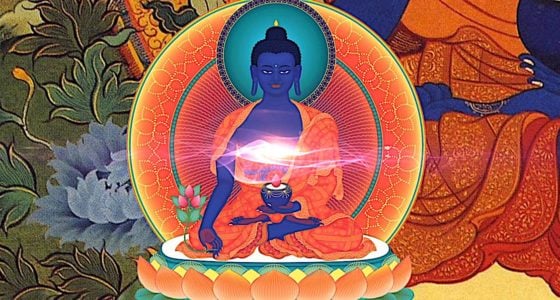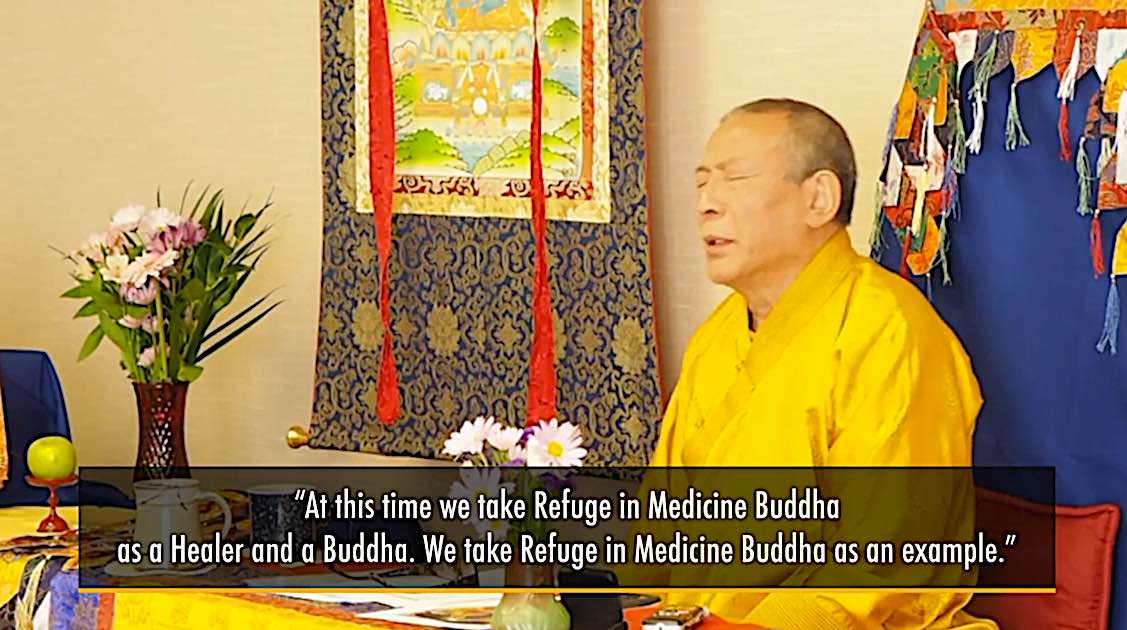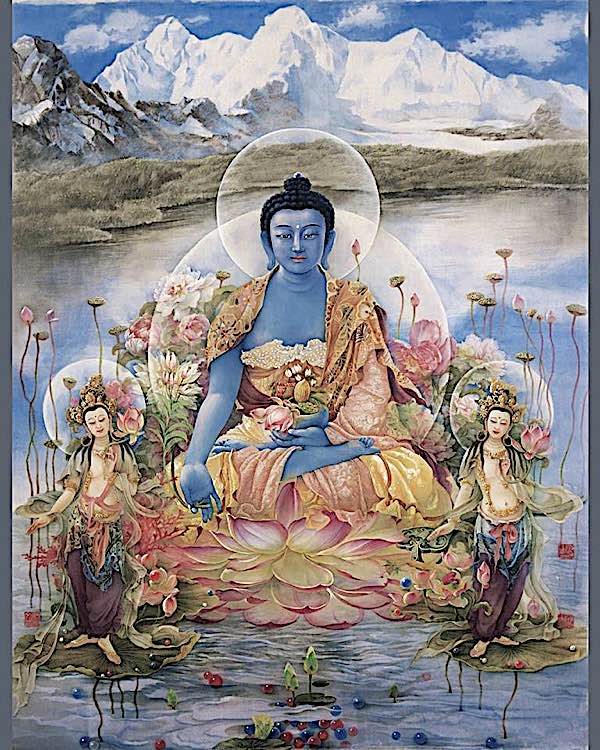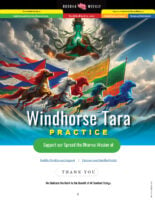Who is Medicine Buddha: King of Lapis Lazuli Light and how can we attain healing blessings?
Medicine Buddha is the Buddha who represents the healing aspects of all the Buddhas. He is also known as Bhaiṣajya-guru in Sanskrit and Yào Shì Fó in Chinese and Lapis Lazuli Light Buddha in English. Medicine Buddha’s mantra is a daily chant for many Buddhists and is the go-to mantra when seeking relief from illness and misfortune.

Medicine Buddha is also regarded as the patron deity of healing and medicine. His sutra, the Bhaiṣajya-guru-vaiḍūrya-prabhā-rāja Sutra, is said to contain 84,000 verses on the subject of medicine and health. Medicine Buddha is typically depicted as the color of lapis lazuli or blue, which symbolizes his power to dispel disease. He is seated on a lotus flower, which represents his purity and wisdom.

Venerable Zasep Tulku Rinpoche’s short visualization guided practice and tips for Medicine Buddha practice (with or without empowerment.)
What are the healing qualities of Medicine Buddha?
Bhaiṣajya-guru-vaiḍūrya-prabhā-rāja is a Healing Buddha who represents the healing power of medicine and compassion. He is also known as the “Medicine Master” or “Doctor Healing King”.

He is believed to have the power to cure all diseases and to bring peace and prosperity —for those who practice with faith. Bhaiṣajya-guru is usually depicted seated on a snow lion throne, with a Medicine Bowl in his left hand and a Branch of Healing Herbs in his right.

He wears the Three Robes of a Buddhist monk and has a blue aura. His nature is blue healing light and he is visualized with a body of shining blue light. In Tibetan Buddhism, Bhaiṣajya-guru is nearly always invoked during meditation for healing. It is said that if you visualize Bhaiṣajya-guru while reciting his mantra, you will be blessed with good health, long life, and prosperity.
Medicine Buddha Features on Buddha Weekly:
- Medicine Buddha Sutra recited by Jason Espada (video)>>
- Medicine Buddha “The First Doctor” main feature, “Empowering you to heal”>>
- Medicine Buddha video retreat, part 1>>

How can we invoke the blessings of Medicine Buddha
The Medicine Buddha is a powerful figure in Tibetan Buddhism. Also known as Bhaiṣajya-guru, he is the Buddha of healing and Medicine. His name means “Lord of Lapis Lazuli”, and he is often depicted holding a lapis lazuli gem in his left hand. The Medicine Buddha is said to have been born from a lotus flower, and he represents the healing power of the Buddha. To invoke his blessings, we can recite his mantra: Om bhaiṣajye bhaiṣajye mahābhaiṣajya-samudgate svāhā. This mantra can be used for protection from illness and for healing purposes. By reciting this mantra, we can ask for the Medicine Buddha’s help in times of need.
Some practical advice for practicing Medicine Buddha
First, it is important to create a shrine dedicated to Medicine Buddha in your home. This can be as simple as setting up a small table with a statue or image of Medicine Buddha, along with some offerings such as flowers or incense.

Second, it is helpful to recite Medicine Buddha’s mantra. This mantra is (in Tibetan form, as usually transmitted today by teachers). Bekhandze, which is Medicine Buddha’s name is more-or-less pronounced phonetically as Beh-kahnd-zey:
Om Bekhandze Bekhandze Maha Bekhandze Bekhandze Randza Samundgate Soha
Chant along with the amazing Yoko Dharma!:
If you prefer the original Sanskrit from the Sutra, it is slightly more difficult to pronounce. For example, the ṣ is pronounced similar to “sh or zha and ā is similar to the “ah” sound. “ai” more or less sounds like “eye”. “ye” is pronounced more or less as “yeh” while “ya” is pronounced “yah.” So Bhaishajye — which is Medicine Buddha’s name — is more or less pronounced as Beye-shag-yeh:
oṃ bhai ṣa jye bhai ṣa jye ma hā
bhai ṣa jya sa mu dga te svā hā
This can also be transliterated as:
oṃ bhaishajye bhaishajye mahābhaishajya-samudgate svāhā

Medicine Buddha’s profound power
If you are looking to tap into these energies in a more profound way, create a sacred space in which to practice. This can be done by setting up an altar with Medicine Buddha’s image, or by simply focusing on his image in your mind. Make offerings to generate merit, usually the eight “sensory” offerings of water for washing, water for drinking, flowers, incense, light (a candle), perfume and food. Food offerings for Medicine Buddha should only be vegan.

Once you have created a space, it is time to begin the practice itself. Sit comfortably and focus on your breath, letting go of all other thoughts. Visualize Medicine Buddha sitting in front of you, and imagine that his Medicine Bowl is filling with light. See this light entering your body, filling you with healing energy. Continue to focus on your breath and the light from the Medicine Bowl until you feel calm and relaxed. Then, when you are ready, open your eyes and slowly begin your day. By taking just a few minutes each day to practice Medicine Buddha Meditation, you can bring more peace and healing into your life.
Reciting the Medicine Buddha Sutra
Another powerful practice suitable for anyone is to recite the short Sutra of Medicine Buddha (the shorter one, not the one with thousands of medicines refered to by Tibetan doctors.). Recite along with Jason Espada. The entire Sutra, at a slow pace, takes 57 minutes. Recite along with beautiful meditative images:
Prayer to Medicine Buddha
Although undertaking the short sadhana of Medicine Buddha is the ultimate practice, it generally requires empowerment.
In absence of the empowerment — which is perfectly fine, since Medicine Buddha is a Sutra teaching — you can still undertake the sadhana, but you visualize the Buddha in front of you — not with yourself arising as the Buddha. (For example, if the Sadhana says you visualize yourself as Lapis Lazuli Light Medicine Buddha, instead you visualize yourself in your normal form (or as your own personal Yidam) but with Medicine Buddha in front of you. In this way you are making offerings and prostrating to the Medicine King.)

You could try this short prayer — recited either in front of your sacred space, or with Medicine Buddha visualized in front of you, surrounded by bountiful visualized offerings (abbreviated from the Gaden Choling Sadhana), translated by Venerable Zasep Rinpoche:
Until I attain enlightenment, I respectfully go for refuge To Guru, Buddha, Dharma and Sangha.
To attain Buddhahood for the welfare of all living beings I shall make requests to Medicine Buddha.
Merely through the touch of the smallest part of your supreme medicinal plant, you cool the fires of the deepest hell, transforming them into lotus pools.
To you, Assembly of Protectors of impure beings, with my body, speech and mind, respectfully I prostrate.
I offer a vast collection of offerings, both actually set out and emanated through the power of mantra, wisdom, and imagination.
I confess all negativities and downfalls, rejoice in virtue, beseech you to remain, and request you to teach.
I dedicate these virtues to great enlightenment.
O Great Assembly of Blessed Ones, please listen to me.
Previously you made prayers,
To fulfil the promises you have made
In this, the final five hundred years of Buddha Shakyamuni’s Teachings; I request you now to show me the truth directly.
O Blessed One, Tathagata, Foe Destroyer, Completely Perfect Buddha, Medicine Guru, Great King with the Radiance of a Lapis Jewel, to you I prostrate, make offerings, and go for refuge.
TAYATA OM BHEKHANDZE BHEKHANDZE MAHA
BHEKANDZE BHEKANDZE RANDZA SAMUNGATE SOHA
Venerable Zasep Rinpoche teachings Buddhist healing practices in a short 10-minute vide0:
More articles by this author
Search
Latest Features
Please support the "Spread the Dharma" mission as one of our heroic Dharma Supporting Members, or with a one-time donation.
Please Help Support the “Spread the Dharma” Mission!

Be a part of the noble mission as a supporting member or a patron, or a volunteer contributor of content.
The power of Dharma to help sentient beings, in part, lies in ensuring access to Buddha’s precious Dharma — the mission of Buddha Weekly. We can’t do it without you!
A non-profit association since 2007, Buddha Weekly published many feature articles, videos, and, podcasts. Please consider supporting the mission to preserve and “Spread the Dharma." Your support as either a patron or a supporting member helps defray the high costs of producing quality Dharma content. Thank you! Learn more here, or become one of our super karma heroes on Patreon.
Lee Kane
Author | Buddha Weekly
Lee Kane is the editor of Buddha Weekly, since 2007. His main focuses as a writer are mindfulness techniques, meditation, Dharma and Sutra commentaries, Buddhist practices, international perspectives and traditions, Vajrayana, Mahayana, Zen. He also covers various events.
Lee also contributes as a writer to various other online magazines and blogs.















